Gorneae (Garni)
Q1010273Gorneae: fortress in eastern Armenia, modern Garni.
Prehistory
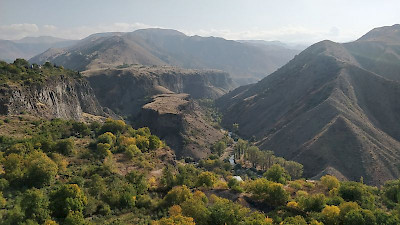
Situated high and safely on a high platform in a bend of the Azat river, Garni has been inhabited since the last quarter of the fourth millennium BCE, i.e. the Chalcolithic age. It is not incomparable to Shengavit (modern Yerevan), which was also inhabited in this period, was also situated on a platform near a river, with people living in round houses. The finds document a community of farmers, growing cereals and breeding cattle.
Another similarity is that Garni was, slowly abandoned in the Early Bronze Age, i.e. the second half of the third millennium BCE. In the early second millennium BCE, Garni was occasionaly used by semi-nomadic shepherds, who migrated with their flocks from one place to another.
It was only after c.1700 BCE, in the Middle Bronze Age, that people settled again in what appears to have been a quite large settlement, some 270 meters long and 80 meters wide and protected by cyclopean walls. In the Late Bronze Age, which began in the fifteenth century BCE, there were several houses, partly subterranean, with square floor plans. This settlement remained in uised until the early ninth century BCE.
Iron Age
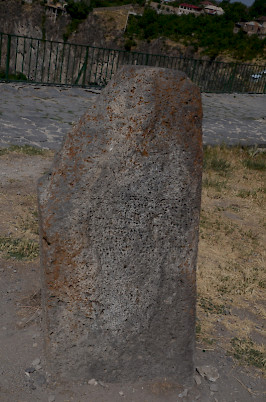
An Urartian inscription that was discovered in 1963 documents how the Urartian king Argište I of Tušpa (r.c.785-756 BCE) defeated the ruler of "the land of Giarniani" and took several men and women captive. (The sign for "land", kur, is clear; there is no reference to a city called Giarniani.) From the fact that Argište erected a stele to commemorate his success, we may deduce that the conquest of Giarniani was a major achievement. Unfortunately, the precise location of the subdued country is unknown, but it must refer to an area between the Urartian city of Erebuni in the west and Lake Sevan in the east.
The Armenian author Moses of Chorene records a tradition that Garni was named after a man named Garnik, a grandson of a Gegham who was a great-grandson of Hayk, the ancestor of all Armenians.note This must be a way of saying that Moses considered the town to be very ancient. It appears that the town was still in use after the fall of Urartu, when the Medes and Persians were the local superpowers, and Orontid rulers were in control of this area.
The Roman historian Tacitus mentions "Gorneae" in his account of a war between the pro-Roman king of Armenia, Mithridates of Iberia, and his nephew Rhadamistus, who tried to succceed his uncle, and besieged him in Garni, "a fort protected by the nature of the ground".note The fortress was betrayed and Rhadamistus became king, which was the immediate cause of a Parthian intervention: in 52 CE, king Vologases put his brother Tiridates on the Armenian throne, which in turn caused a major war with the Roman Empire, because traditionally, the Romans appointed the Armenian king. After several years, a compromise was found: Tiridates resigned and was reappointed by the emperor Nero (66 CE).
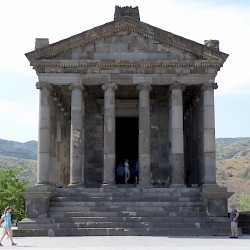 Garni, Roman-style monument |
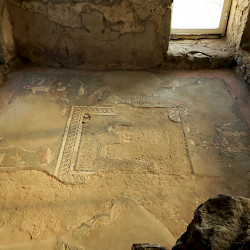 Garni, Bathhouse, Mosaic |
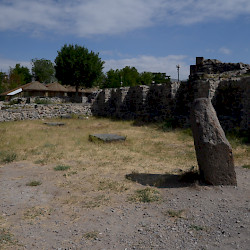 Garni, Palace, Audience Hall |
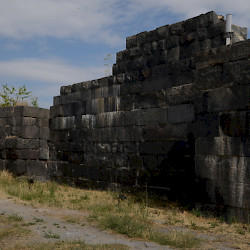 Garni, Wall |
Monuments
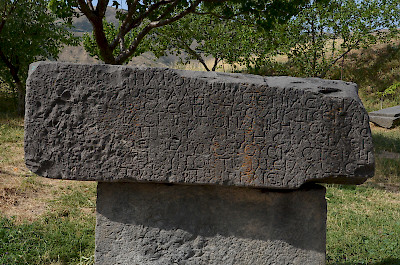
An inscription, found in 1945 on the cemetery of Garni, documents building activities by a king named Tiridates Helios the Great, lord of Greater Armenia. It mentions that in the eleventh year of his reign, he built an impregnable fortress for his sister.note It is not entirely clear whether this refers to an eleventh regnal year after Tiridates had been appointed by Vologases or by Nero (in other words, whether it refers to the year 63 or 77); nor is it clear to which monuments it refers.
However this may be, several monuments were built in Garni in the first centuries of our era:
- a city wall that still rises some six meters, with fourteen towers, made of basalt;
- a monument resembling a Roman temple;
- a palace with a bathhouse.
It is not clear whether the temple-like monument is indeed a sanctuary built by Tiridates or is in fact a mausoleum from the second half of the second century CE, nor is it clear whether the inscription refers to this building. The palace and the bathhouse appear to date to the third century.
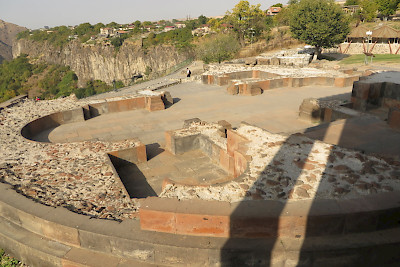
Even younger is the church, which is usually dated to the seventh century, and was devoted to Sacred Zion. This circular sanctuary must have resembled the cathedral of Zvartnots and may have had several storeys. Another church, called Khumarazham, was built outside the fortress in what is now the modern town of Garni.
Garni was destroyed when the Arabs invaded Armenia in the 640s but rebuilt. In 898, the leader of the Armenian Christians, catholicos Mashtots Yeghvardetsy, was buried near the entrance of the church of Sacred Zion.
Literature
A. Philipossian e.a., Garni (s.a., but after 2011)